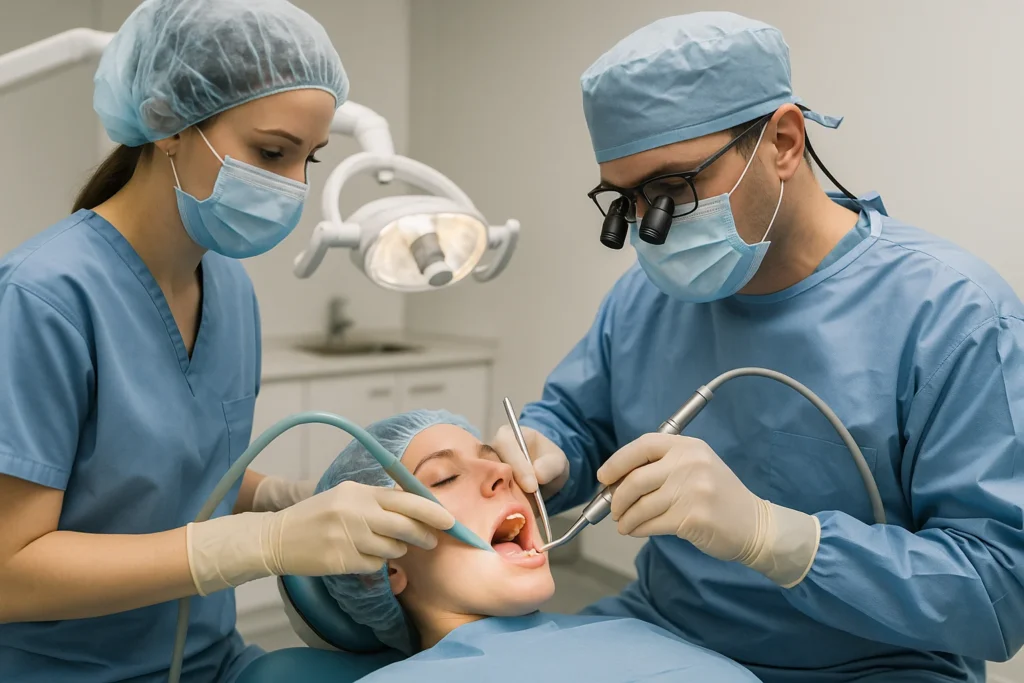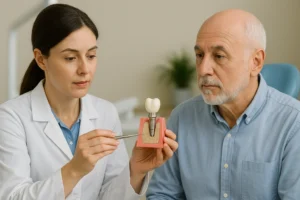Before diving into the specifics, it’s important to understand the basics of sedation and anesthesia. Sedation in dentistry is used to relax patients during procedures, ranging from mild relaxation to deep sedation. This can significantly reduce the fear and apprehension that many feel when faced with dental surgery. Anesthesia, on the other hand, typically refers to a state of controlled, temporary loss of sensation or awareness, often used for more extensive oral surgeries. It ensures that patients do not experience pain or discomfort during the procedure.
Types of Sedation and Anesthesia
Understanding the types of sedation and anesthesia available can help you and your dentist choose the best option for your specific needs. Each type offers varying levels of consciousness and relaxation, tailored to the complexity of the procedure and your comfort level.
Conscious Sedation Dentistry
Conscious sedation is a popular choice for patients undergoing dental procedures. It allows you to remain awake and responsive while feeling relaxed and at ease. This type of sedation is ideal for patients who experience anxiety or fear related to dental visits. It bridges the gap between complete unconsciousness and full alertness, offering a balance that reassures many patients.
- Oral Sedation: Oral sedation involves taking a pill, usually a benzodiazepine, about an hour before the procedure. It helps to calm nerves and induce drowsiness, making the experience more pleasant. The effects can range from mild to moderate, depending on the dosage and individual response, and patients often report feeling like time flies during the procedure.
- Nitrous Oxide (Laughing Gas): Nitrous oxide is administered through a mask placed over your nose. It provides a calming effect and wears off quickly, allowing you to drive home after the procedure. This method is particularly favored for its minimal side effects and quick recovery time, making it ideal for less invasive procedures.
IV Sedation Oral Surgery
IV sedation is a step up from conscious sedation, providing a deeper state of relaxation. A sedative drug is administered through an intravenous line, and the effects are felt almost immediately. This method is particularly beneficial for longer or more complex procedures where a higher level of sedation is needed. While you remain conscious, you may not remember much about the procedure afterward, which can be a relief for those with dental phobias.
General Anesthesia Oral Surgery
General anesthesia is used for more complex oral surgeries, where deeper sedation is required. Under general anesthesia, you are completely unconscious and will have no memory of the procedure. This type of anesthesia is usually reserved for extensive surgeries or patients with special needs. It requires careful monitoring and is typically performed in a hospital or specialized surgical center to ensure the highest safety standards.
Safety of Sedation and Anesthesia
The safety of sedation and anesthesia in oral surgery is a top concern for both patients and dental professionals. Ensuring a safe experience involves several layers of precaution and expertise, all aimed at minimizing risks and enhancing patient comfort.
Qualifications of the Oral Surgeon
According to the American Association of Oral and Maxillofacial Surgeons, anesthesia in oral surgery is a safe and routine practice when administered by trained professionals.
Ensure that your oral surgeon is well-trained and experienced in administering sedation and anesthesia. They should be certified and have the necessary credentials to perform these procedures safely. The surgeon’s experience plays a critical role in managing unexpected situations and ensuring a smooth procedure.
Monitoring During the Procedure
During sedation, your vital signs, such as heart rate, blood pressure, and oxygen levels, are closely monitored. This helps to ensure that any potential complications are quickly addressed. Continuous monitoring allows the surgical team to adjust sedation levels as needed, ensuring optimal comfort and safety.
Pre-Surgery Assessment
Before your surgery, your oral surgeon will conduct a thorough assessment to determine the best sedation option for you. This assessment includes reviewing your medical history, allergies, and any medications you’re currently taking. It’s a personalized evaluation that helps in tailoring the sedation plan to your specific needs, thereby minimizing risks.
If you have questions about which sedation option is right for you, contact our oral surgery team to schedule a consultation.

Recovery Tips After Sedation and Anesthesia
A smooth recovery is essential for healing after oral surgery. Proper post-operative care can significantly impact your overall healing time and comfort. Here are some tips to help you recover comfortably and quickly:
Immediate Post-Operative Care
- Have a Companion: After the procedure, you will need someone to drive you home and stay with you for at least the first 24 hours. This support is crucial as you might still feel groggy or unsteady due to the lingering effects of sedation.
- Rest: Take it easy for the rest of the day. Avoid strenuous activities and allow your body to heal. Rest promotes recovery and helps reduce the risk of complications such as bleeding or swelling.
Managing Discomfort
- Pain Management: Follow your oral surgeon’s instructions regarding pain medications. Over-the-counter pain relievers may be recommended, or you might be prescribed stronger medication. Staying ahead of the pain by taking medications as directed can make a significant difference in your comfort level.
- Cold Compresses: Applying cold compresses to the outside of your face can help reduce swelling and discomfort. This simple technique can also help minimize bruising and is most effective when used in the first 48 hours post-surgery.
Nutrition and Hydration
- Soft Diet: Stick to a soft diet for the first few days after surgery. Foods like yogurt, mashed potatoes, and smoothies are gentle on your healing mouth. Avoid hot, spicy, or crunchy foods that could irritate the surgical site.
- Stay Hydrated: Drink plenty of fluids to stay hydrated. Avoid using straws, as the suction can disrupt the healing process. Hydration is key to recovery, but be mindful of what you drink; avoid alcohol and caffeine.
Oral Hygiene
- Gentle Brushing: Be gentle when brushing your teeth and avoid the surgical area. Follow your surgeon’s instructions on when to resume regular brushing and flossing. Keeping your mouth clean is essential, but overzealous brushing can hinder healing.
- Rinsing: Use a warm saltwater rinse to keep your mouth clean and promote healing. Avoid mouthwash with alcohol, as it can irritate the surgical site. Saltwater rinses are soothing and help reduce bacteria in the mouth, supporting a healthier recovery environment.
Follow-Up Appointments
Attend all follow-up appointments scheduled by your oral surgeon. These visits are crucial for monitoring your healing process and addressing any concerns you may have. Follow-up care provides an opportunity to catch potential issues early and ensure that your recovery is progressing as expected.
Sedation for Anxious Patients
For patients who experience significant anxiety about dental procedures, sedation dentistry can be a game-changer. By utilizing sedation techniques, patients can undergo necessary treatments without the stress and fear that often accompany dental visits. This approach can transform the dental experience from one of dread to one of calm and control.
Benefits of Sedation for Anxious Patients
- Reduced Anxiety: Sedation helps calm nerves and creates a more relaxed experience. This reduction in anxiety can also lead to improved cooperation during the procedure, making it easier for both the patient and the dental team.
- Comfortable Procedures: Patients often report feeling more comfortable and less aware of the procedure. The sensation of time passing quickly can make even lengthy procedures seem brief and manageable.
- Efficient Treatment: Sedation can allow your dentist to perform multiple procedures in one visit, reducing the number of appointments needed. This efficiency not only saves time but also minimizes the emotional and logistical stress of multiple dental visits.
Conclusion
Choosing the right sedation and anesthesia options for oral surgery is crucial for a comfortable and stress-free experience. By understanding the different types of sedation, ensuring the safety of the procedure, and following recovery tips, you can promote a smooth healing process. Always consult with your oral surgeon to determine the best option tailored to your needs. Whether you’re a patient prone to anxiety or undergoing a complex procedure, sedation dentistry offers solutions to meet your unique requirements. With the right approach, oral surgery can be a manageable and even positive experience, paving the way for better dental health.



